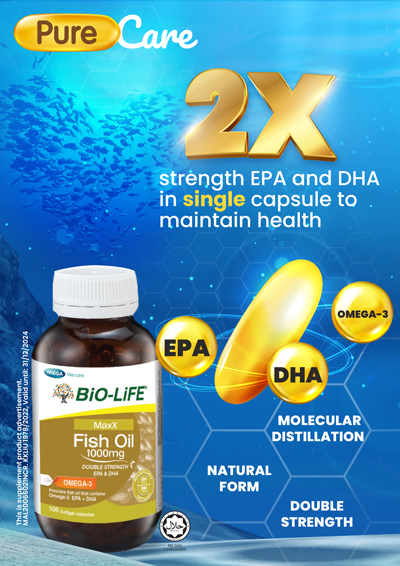
Omega-3 Supplementation and Cardiovascular Health – What’s the Updates?
Sep 02, 2021
A study revealed that omega-3 fatty acids intake among Malaysian is poor and far from desirable1. Both EPA and DHA are long-chain omega-3 polyunsaturated fatty acids that are essential to humans as they cannot be produced by the body. Studies have shown that omega-3 fatty acids EPA and DHA have various benefits, particularly cardiovascular health.
Fatty fish such as anchovies, mackerel, and salmon, are rich in omega-3 fatty acids. If you could not consume fatty fish, then you may consider supplementation. The fish oil in fatty fish is naturally present in triglyceride form (natural form). Some fish oil supplements are in esters form (synthetic form). It has been shown that the bioavailability of fish oil in reconstituted triglyceride form is better than ethyl esters form2.
Most health organizations recommended 250mg to 500mg of combined EPA and DHA daily for healthy adults to maintain their health. However, a higher dosage of EPA and DHA, a minimum of 2g daily is required to help to lower down high triglyceride level3.

BiO-LiFE MaxX Fish Oil 1000mg Double Strength is a double strength fish oil that can provide TWICE the amount in typical fish oil, which is 360mg EPA and 240mg DHA in reconstituted triglyceride form, a high purity fish oil that is processed through molecular distillation.
Thus, for those individuals that wish to reduce their high triglyceride level with omega-3 EPA and DHA, by choosing BiO-LiFE MaxX Fish Oil 1000mg Double Strength, they do not need to swallow so many capsules to achieve the therapeutic dosage. Lastly, if you need a higher dosage, always get advice from a healthcare professional so that they can recommend it according to your health conditions, as fish oil needs to be used with caution if taking blood thinning medicine, ginkgo, high dose of vitamin E.
References
- Dyerberg, J., Madsen, P., Møller, J. M., Aardestrup, I., & Schmidt, E. B. (2010). Bioavailability of marine n-3 fatty acid formulations. Prostaglandins, Leukotrienes and Essential Fatty Acids, 83(3), 137-141
- Tony, K.W.N., et.al. (2012). Omega-6 and omega-3 fatty acid nutrition amongst Malaysians are far from desirable. International e-Journal of Science, Medicine & Education, 6(2):4-9
- Skulas-Ray, A. C., et.al. (2019). Omega-3 Fatty Acids for the Management of Hypertriglyceridemia: A Science Advisory from the American Heart Association. Circulation, 140(12), e673–e691



